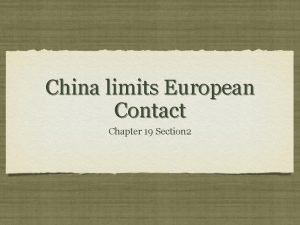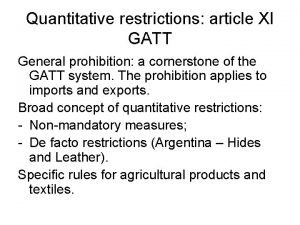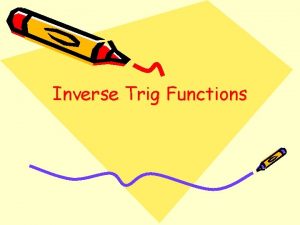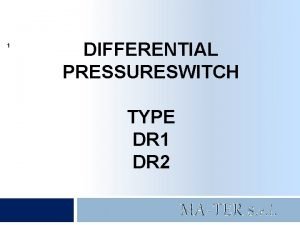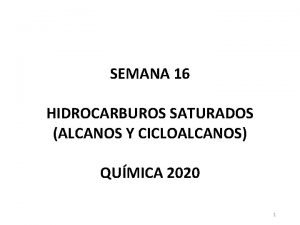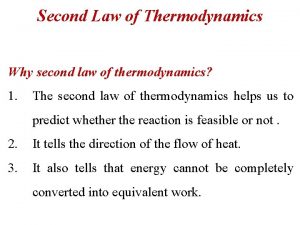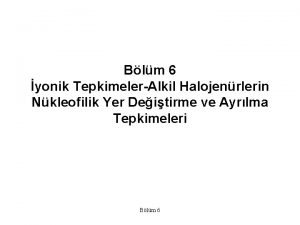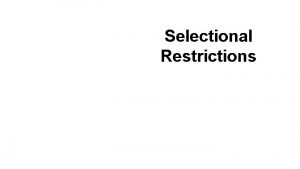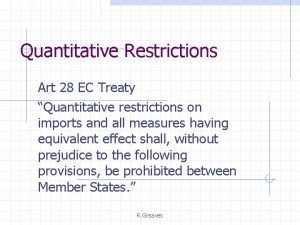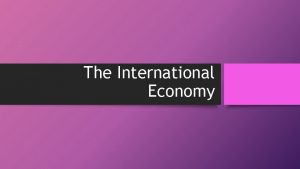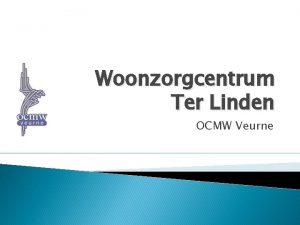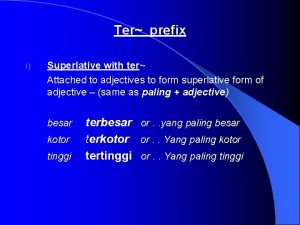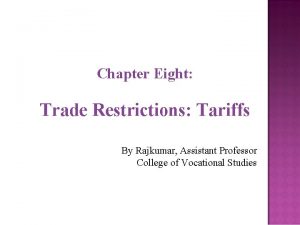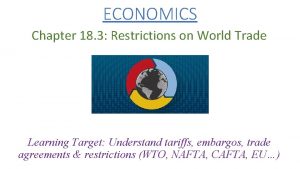CHAPCChapte Cr 5 TER Chapter 5 Trade Restrictions








































- Slides: 40

CHAPCChapte. Cr 5 TER Chapter 5 Trade Restrictions: Tariffs D. Salvatore"Introduction to International Trade" Adapted by Dr. Mohamed A. Abdalla 1

Movements away from free trade n While it is generally accepted that free trade best enhances societal welfare, complete free trade is seldom practiced. n This situation generates two questions: n Why is complete free trade seldom practiced? n What are the effects of deviating from free trade? n This chapter considers the second question by considering the effects of employing one common tool of deviating from free trade – the tariff. D. Salvatore"Introduction to International Trade" Adapted by Dr. Mohamed A. Abdalla 2

Tariffs: Definition A TARIFF is a tax levied upon a commodity when it crosses national boundaries. It is usually designed to provide revenue or protection to domestic producers. PROTECTION Versus. REVENUE: n Revenue Tariff: Provide revenue only and no protection. n Prohibitive Tariff: Provide only protection and no revenue. n In between tariff usually provide both revenue and protection. n Import vs. export tariffs n An import tariff is a tax (or duty) on imported goods or services. n This is the most common form of tariff. n An export tariff is a tax on exported goods or services. n This is rarely seen in developed countries but is occasionally practiced in developing countries to generate government revenue. D. Salvatore"Introduction to International Trade" Adapted by Dr. Mohamed A. Abdalla 3

Types of tariffs n Ad valorem tariff A fixed % tax on the value of the traded commodity (allows grade variation – automobiles). n Specific tariff n A fixed sum tax per physical unit of a traded commodity (standardized products – Mineral Water) n A compound tariff n A combination of an ad valorem and specific tariff. n D. Salvatore"Introduction to International Trade" Adapted by Dr. Mohamed A. Abdalla 4

ADVANTAGES AND DISADVANTAGES Ad valorem: More equitable and provide constant protection during inflation. n Specific duty : Easy to administer. n Since there advantages and disadvantages to both types of duties, a sensible compromise may be to use the specific duty for standardized products and ad valorem duty for goods with a wide range of grade. COMMODITY EVALUATION: n F. O. B – Free On Board (U. S) n C. I. F – Cost, Insurance, and Freight, (Europe). n D. Salvatore"Introduction to International Trade" Adapted by Dr. Mohamed A. Abdalla 5

Economic Effects of Tariffs n The implications of interfering with trade differ depending on the nature of the country. n The key distinction is between whether the country is “small” or “large. ” n A “small” country is one where changes in its domestic market do not alter the international price of the commodity. n In the case of a tariff, this means that the imposition of a tariff does not alter the international price. n In other words, the country acts as a “price-taker” in the international market. n A “large” country is one where changes in its domestic market do alter the international price of the commodity. n In the case of a tariff, this means that the imposition of a tariff does alter the international price. D. Salvatore"Introduction to International Trade" Adapted by Dr. Mohamed A. Abdalla 6

Effects of a tariff: small country n The effects of a tariff are easily seen in a market supply and demand diagram. n In this market, the autarky equilibrium occurs a price of $50 and quantity of 50. D. Salvatore"Introduction to International Trade" Adapted by Dr. Mohamed A. Abdalla 7

Effects of a tariff: small country n In this market, if the international price is $20, the country will be an importer of the item. n Domestic production will fall from 50 to 20. n Domestic consumption will rise from 50 to 80. n These changes generate imports of 60 units. D. Salvatore"Introduction to International Trade" Adapted by Dr. Mohamed A. Abdalla 8

Effects of a tariff: small country n If a 50% ad valorem tariff is placed on imports, the domestic price rises from $20 (the international price) to the tariff price of $30. n Domestic production increases from 20 to 30. n Domestic consumption falls from 80 to 70. n Imports fall to 40. D. Salvatore"Introduction to International Trade" Adapted by Dr. Mohamed A. Abdalla 9

Effects of a tariff: small country n The final effect is that the government will begin collecting tariff revenue in this market. n The amount of the revenue is $10 x 40 = $400 per unit of time. D. Salvatore"Introduction to International Trade" Adapted by Dr. Mohamed A. Abdalla 10

Welfare effects: small country n To show the welfare changes from the tariff the concepts of consumer and producer surplus must be considered. n Consumer surplus is the difference between what consumers are willing to pay for a specific amount of a commodity and what they actually pay for it. n Graphically, consumer surplus is the area under the demand curve and above the price paid on every unit purchased. n Producer surplus is the extra payment received by producers above what needed to have been paid to cause them to produce the commodity. n Graphically, producer surplus is the area below the price received and above the supply curve on every unit sold. D. Salvatore"Introduction to International Trade" Adapted by Dr. Mohamed A. Abdalla 11

Welfare effects: small country n Consumer surplus at autarky is given by the indicated region. n When the nation moves to free trade this surplus increases. n The imposition of a tariff reduces this surplus by the difference between the international and the tariff price. D. Salvatore"Introduction to International Trade" Adapted by Dr. Mohamed A. Abdalla 12

Welfare effects: small country n Producer surplus at autarky is given by the shaded region. n Opening the economy to free trade reduces the surplus to the smaller shaded region. n Imposing a tariff increases the producer surplus. D. Salvatore"Introduction to International Trade" Adapted by Dr. Mohamed A. Abdalla 13

Welfare effects: small country n The losses and gains from the imposition of a tariff exist in the shaded region. n The entire region is lost consumer surplus. n The dollar value of this region is ($10 x 70) + (½ x $10 x 10) or $750. D. Salvatore"Introduction to International Trade" Adapted by Dr. Mohamed A. Abdalla 14

Welfare effects: small country n The entire region is lost consumer surplus. n Of this, the portion above the supply curve is gained by producers. n The dollar value of this region is ($10 x 20) + (½ x $10 x 10) or $250. D. Salvatore"Introduction to International Trade" Adapted by Dr. Mohamed A. Abdalla 15

Welfare effects: small country n The entire region is lost consumer surplus. n Of this, the portion above the supply curve is gained by producers. n The rectangular area is gained by the government as tariff revenue. n The dollar value of this region is $10 x 40 or $400. D. Salvatore"Introduction to International Trade" Adapted by Dr. Mohamed A. Abdalla 16

Welfare effects: small country n This leaves a net welfare loss to society of the two triangular shaded regions. n These regions are known as the deadweight loss of a tariff. n These have a dollar value of $750 - $250 (gained by producers) $400 (gained by the government) or $100. D. Salvatore"Introduction to International Trade" Adapted by Dr. Mohamed A. Abdalla 17

Economic Effects of Tariffs: Small Country (a general presentation) The Effects of a Tariff on a single good with fixed world price: The n n n case of a Small Country (Figure 1 , next slide): A small country imposes a tariff on imports of a good in the amount of $T. Since the country is small and cannot affect the world price – world price stays constant at PW. But price of imports rises by the full amount of the tariff to Pt = PW + T. Producers supply more of the good and consumers demand less due to the higher price, so that fewer imports are demanded. Thus, the volume of imports declines due to the imposition of the tariff. D. Salvatore"Introduction to International Trade" Adapted by Dr. Mohamed A. Abdalla 18

Economic Effects of Tariffs: Small Country (a general presentation) Figure 1: Domestic Effects of a Tariff for a Small Country Price S P 1 E P Tariff = T Pt G a c b Pw d F D P 2 Q 1 Q 3 Q Q 4 Q 2 19 Quantity

Economic Effects of Tariffs: Small Country (a general presentation) In the Figure: a+b+c+d: loss in consumer surplus. a: a transfer of consumer surplus to producer surplus. b: cost of resources transferred from their best use to the production of more of the imported good (Q 1 to Q 3). n c: tariff revenue that the government collects. n a + c: redistributed from consumers to the producers and government. n b + d: net loss to society (dead-weight loss) of consumer welfare. n n D. Salvatore"Introduction to International Trade" Adapted by Dr. Mohamed A. Abdalla 20

Economic Effects of Tariffs: Small Country (a general presentation) Effects on the importing country: n Consumption effect (Forces consumers to purchase less desirable products). n Production effect (reallocation of resources in favour of substitutes for tariff-driven imports). n Mathematically: Welfare effects is measured as: ∆W = ½ (T)(∆M) (= area b + area d) This is true since: Area of triangle b = ½ T x Q 1 Q 3 Area of triangle d = ½ T x Q 4 Q 2 ∆W = a + b = ½ T (Q 1 Q 3 + Q 4 Q 2) = ½ T (∆M) D. Salvatore"Introduction to International Trade" Adapted by Dr. Mohamed A. Abdalla 21

Effects of a tariff: large country n The effects of a tariff on a large country differ from that in a small country because the imposition of a tariff results in a fall in import demand that lowers the international price. n This is known is as the terms of trade effect. D. Salvatore"Introduction to International Trade" Adapted by Dr. Mohamed A. Abdalla 22

Effects of a tariff: large country n In this case, the 50% tariff results in a drop of the international price from $20 to $15. n This takes the tariff price to $22. 50 per unit. n The effects of this change are more clearly seen through a narrowing of focus in the graph. D. Salvatore"Introduction to International Trade" Adapted by Dr. Mohamed A. Abdalla 23

Effects of a tariff: large country n With the tariff and improvement in the terms of trade, production rises from 20 to 22. 5 units. n Consumption falls from 80 to 77. 5 units. n Imports fall from 60 to 55 units. D. Salvatore"Introduction to International Trade" Adapted by Dr. Mohamed A. Abdalla 24

Welfare effects: large country n Consumer surplus declines by the shaded region. n This has a dollar value of ($2. 50 x 77. 5) + (½ x $2. 50 x 2. 5) = $196. 875 D. Salvatore"Introduction to International Trade" Adapted by Dr. Mohamed A. Abdalla 25

Welfare effects: large country n Consumer surplus declines by the shaded region. n Producer surplus increases by the shaded region offsetting part of the consumer loss. n This has a dollar value of ($2. 50 x 20) + (½ x $2. 50 x 2. 5) = $53. 125 D. Salvatore"Introduction to International Trade" Adapted by Dr. Mohamed A. Abdalla 26

Welfare effects: large country n Consumer surplus declines by the shaded region. n Producer surplus increases by the shaded region offsetting part of the consumer loss. n Government revenue increases by $10 x 55 or $550. D. Salvatore"Introduction to International Trade" Adapted by Dr. Mohamed A. Abdalla 27

Welfare effects: large country n The net effect is a welfare gain. n n Consumer surplus falls by $196. 875 Producer surplus rises by $53. 125 Government revenue increases by $550 This generates a net gain of $406. 25 for this case. D. Salvatore"Introduction to International Trade" Adapted by Dr. Mohamed A. Abdalla 28

Welfare effects: large country n This result arises as the improvement in the terms of trade more than offsets the potential deadweight loss of the tariff. n n Welfare lost Welfare gained D. Salvatore"Introduction to International Trade" Adapted by Dr. Mohamed A. Abdalla 29

Economic Effects of Tariffs: Large Country (a general presentation) The Effects of a Tariff on a single good with variable world price: The case of Large Country (Figure 2 , next slide): q A large country imposes a tariff on imports of a good in the amount of $T. n Since the country is large it can affect the world price – world price decreases to EP. n Domestic price of imports rises by less than the full amount of the tariff to DP, decreasing imports. n Decrease in both imports and world price, decrease world supply and exporting country experience loss. n Thus, the volume of imports declines due to the imposition of the tariff. D. Salvatore"Introduction to International Trade" Adapted by Dr. Mohamed A. Abdalla 30

Economic Effects of Tariffs: Large Country (a general presentation) Figure # 2: Tariff on a single good with a variable world price: Large country case P S D d b DP c g WP EP Q 1 Q 3 Q 4 Q 2 D. Salvatore"Introduction to International Trade" Adapted by Dr. Mohamed A. Abdalla Q 31

Economic Effects of Tariffs: Small Country (a general presentation) n Domestic price rises to DP. n World price falls to EP. n Tariff revenue = c + g. Exporting country: experiences a welfare loss since producer surplus decreases. Importing country: Two effects: - TOT effect = PX/PM Since PM ↓ → TOT ↑. - Consumer surplus decrease. Net world welfare loss = b + d Two effects of tariff: ↓Volume of trade and ↑ TOT. Optimum Tariff: A tariff that maximizes net gain ( g – b - d). D. Salvatore"Introduction to International Trade" Adapted by Dr. Mohamed A. Abdalla 32

Optimum tariff n The previous example demonstrates that it is possible for the n n n imposition of a tariff in a large county to improve societal welfare. An optimal tariff is the tariff rate that maximizes the benefit resulting from the imposition of a tariff. n The gain comes from the improvement in the terms of trade. Positive welfare gains are always possible from tariff imposition in large countries. A concern about the optimal tariff By itself, the existence of an optimum tariff appears to be a strong argument for interfering with free trade. It is important to note that the positive welfare gains exist only if no retaliation in other markets occurs following the imposition of a tariff. n History does not support the no retaliation assumption. D. Salvatore"Introduction to International Trade" Adapted by Dr. Mohamed A. Abdalla 33

Nominal tariffs vs. effective protection n The nominal tariff is the percentage increase in the price of the final commodity. n A 50% ad valorem tariff raises the price of the commodity by 50% generating a 50% nominal tariff. n The effective rate of protection is calculated on the increase in domestic value added offered by tariff protection. n The effective rate of protection offers a better measure of the protection offered producers as it takes into account the cost to producers of tariffs on input markets D. Salvatore"Introduction to International Trade" Adapted by Dr. Mohamed A. Abdalla 34

Examples of effective protection n Suppose a product sells for $10, 000 but has input costs of $5, 000 per unit. n In this case, its value added is $5, 000. n The imposition of a 10% ad valorem tariff raises the sales price from $10, 000 to $11, 000. D. Salvatore"Introduction to International Trade" Adapted by Dr. Mohamed A. Abdalla 35

Examples of effective protection n The imposition of a 10% ad valorem tariff raises the sales price from $10, 000 to $11, 000. n This raises the value added from $5, 000 to $6, 000 and offers an effective rate of protection of 20%. n Gain $1, 000 (gain in value added) ÷ $5, 000 (original value added) = 20% D. Salvatore"Introduction to International Trade" Adapted by Dr. Mohamed A. Abdalla 36

Examples of effective protection n Using the starting point, assume that a 20% ad valorem tariff is placed on the inputs. n This raises the input cost from $5, 000 to $6, 000. D. Salvatore"Introduction to International Trade" Adapted by Dr. Mohamed A. Abdalla 37

Examples of effective protection n Using the same example, assume that a 20% ad valorem tariff is placed on the inputs. n This raises the input cost from $5, 000 to $6, 000. n This decreases the value added from $5, 000 to $4, 000 and offers an effective rate of protection of - 20%. n - $1, 000 (loss in value added) ÷ $5, 000 (original value added) = - 20% D. Salvatore"Introduction to International Trade" Adapted by Dr. Mohamed A. Abdalla Loss 38

Examples of effective protection n As a final example, consider the effective rate of protection offered by combing the previous two policies – a 20% tariff on the inputs and a 10% tariff on the final output. D. Salvatore"Introduction to International Trade" Adapted by Dr. Mohamed A. Abdalla 39

Examples of effective protection n This increases both input cost and final price by $1, 000 and leaves an effective rate of protection of zero. n As is seen, the effective level of protection may differ greatly from the rate of the nominal tariff. D. Salvatore"Introduction to International Trade" Adapted by Dr. Mohamed A. Abdalla Gain Loss 40
 Chapter 19 section 2 china limits european contacts
Chapter 19 section 2 china limits european contacts Quem tem um amigo achou um tesouro
Quem tem um amigo achou um tesouro Type 86 entry
Type 86 entry Article xi of gatt
Article xi of gatt Examination permit nj restrictions
Examination permit nj restrictions Unit 6 lesson 1 permutations and combinations
Unit 6 lesson 1 permutations and combinations What is dharma
What is dharma Public ignores prohibition restrictions
Public ignores prohibition restrictions Range of inverse trig functions
Range of inverse trig functions Trade diversion and trade creation
Trade diversion and trade creation Umich
Umich Trade diversion and trade creation
Trade diversion and trade creation The trade in the trade-to-gdp ratio
The trade in the trade-to-gdp ratio Fair trade not free trade
Fair trade not free trade Trade diversion and trade creation
Trade diversion and trade creation Tramp liner
Tramp liner Ted talk slave trade
Ted talk slave trade Grootste bulldozer ter wereld
Grootste bulldozer ter wereld Verbo trazer
Verbo trazer Texto seja feliz voce pode ter defeitos
Texto seja feliz voce pode ter defeitos Fattura 74 ter
Fattura 74 ter Pretérito perfeito
Pretérito perfeito Mas e a vida ela é alegria ou é sofrimento
Mas e a vida ela é alegria ou é sofrimento Pretérito perfeito ter
Pretérito perfeito ter Por que o entrevistado não vai agradecer por ele ter vindo
Por que o entrevistado não vai agradecer por ele ter vindo Barney tan
Barney tan Si pater filium ter venum duit filius a patre liber esto
Si pater filium ter venum duit filius a patre liber esto Huis ter leye
Huis ter leye Uma das coisas que eu acho fascinante em jesus
Uma das coisas que eu acho fascinante em jesus Spleetvulkanen
Spleetvulkanen Ma-ter dr1
Ma-ter dr1 Desgnios
Desgnios Iso sec ter neo
Iso sec ter neo A thermal energy reservoir (ter) has
A thermal energy reservoir (ter) has Stage master 2 biologie
Stage master 2 biologie Forma nominal do verbo
Forma nominal do verbo Verbo ter presente
Verbo ter presente A princípio bastaria ter
A princípio bastaria ter Margreet ter steege
Margreet ter steege Presente atemporal
Presente atemporal Alkanların yer değiştirme tepkimeleri
Alkanların yer değiştirme tepkimeleri
